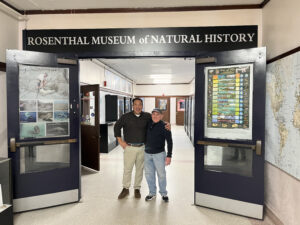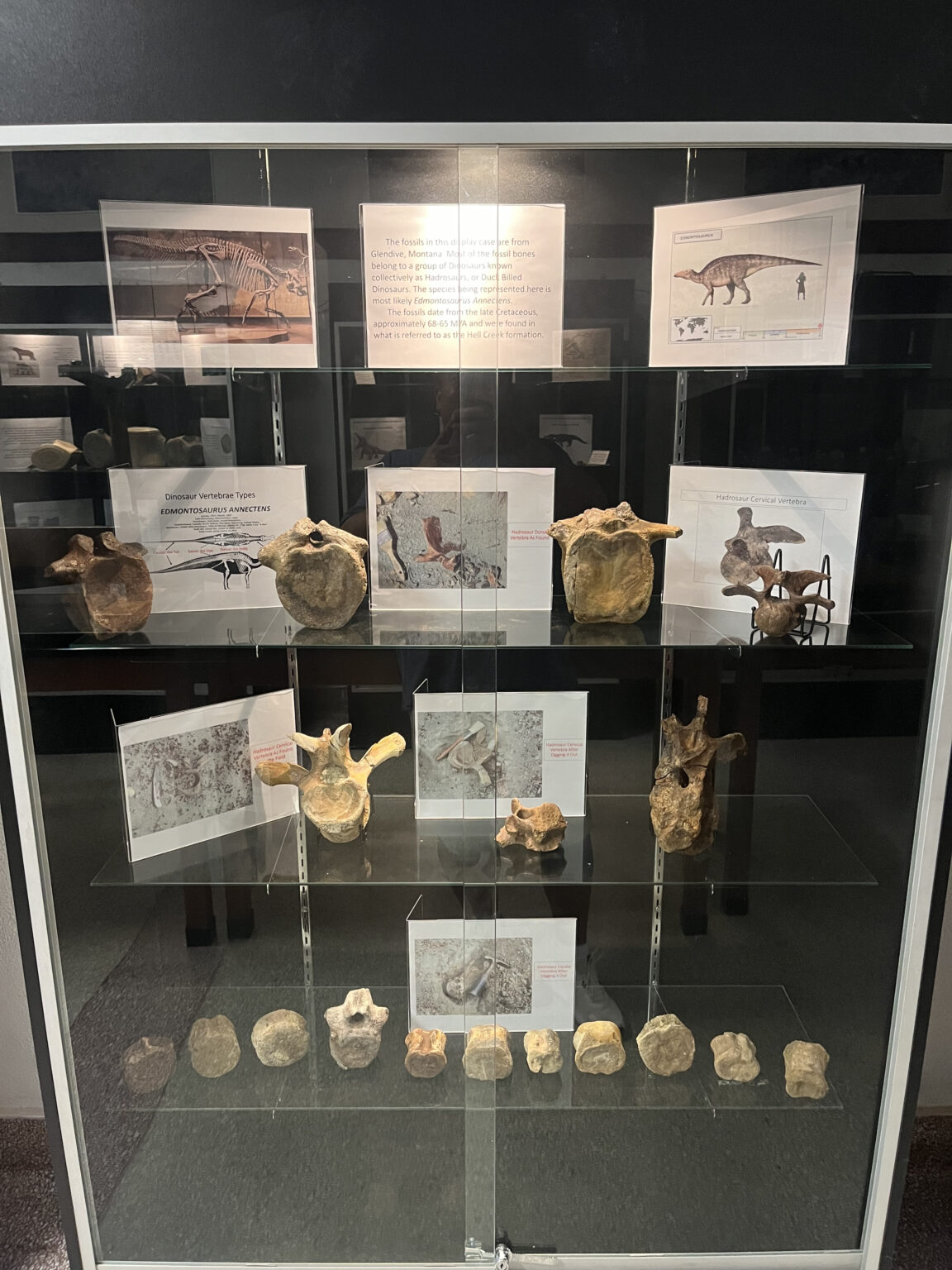Sam Rosenthal, Portland High School Class of 1971, used to think that dinosaur-hunting required a degree in paleontology.
“For a long time, I thought that only professionals could find fossils,” Rosenthal said. Then, on a work trip in the 90s, his boss asked if he wanted to collect fossils of ammonites (extinct shelled cephalopods) when they had an extra day. “He took me out and collected. I was amazed. I said, ‘Wow, I guess you don’t have to be a PhD!’ I didn’t realize it was that easy.”
Three decades later, the product of Rosenthal’s own fossil hunts can be seen on the third floor of Portland High School, home of the Rosenthal Museum of Natural History.
The collection spans a time frame from the Pleistocene to the late Cretaceous, approximately 20,000 to 68 million years ago. Fossils that are on display include not just ammonites, but also fossilized alligator jaws, the massive teeth of a megalodon (an extinct species of shark more than three times the size of modern Great Whites), the ribs and vertebra of ancient dugongs (marine mammals similar to manatees), ancient horse teeth, and fossils of fish. The real treat for Rosenthal, though, and for kids and adults of all ages, is the large collection of dinosaur bones. Four large display cases hold only dinosaur bones.
“I became fascinated by dinosaurs as a small child, and I never lost my fascination,” Rosenthal said.
The collection at Portland High School makes that clear. It includes a triceratops nose horn and parts of its frill, a hadrosaur bone with a bite mark in it (perhaps from an attack that killed it or from some scavenger after its death), bones and vertebra from the ostrich-like struthiomimus, and rare hand and foot bones from a relative of the velociraptor, a dinosaur made famous by “Jurassic Park.”
Rosenthal has been working with Eric Begonia, a biology teacher at Portland High, to bring the museum to life.
(photo: Eric Begonia, left, Sam Rosenthal, right)
“Mr. Begonia and I work on a display case-by-display case basis,” Rosenthal said. The museum has eight cases on display now, and Rosenthal has more material to come.
Rosenthal always had a mind for science. He fondly remembered the math and science teachers at Portland High School who impacted his life.
“I had a teacher, Ms. Fournier, in chemistry–one of the best teachers I ever had,” Rosenthal said. “Awesome teacher. Incredibly knowledgeable.”
What endeared Fournier to Rosenthal was that she demanded the most of her students.
“To give you an idea of how hard Ms. Fournier’s course was, of the two sections in the first quarter, no one got an A,” he said. “I got the highest grade and I got a B. I was bound and determined to get an A from Ms. Fournier. I improved every quarter. Second quarter, I got a B+, third quarter I got an A-, and fourth quarter I got an A.”
Rosenthal was so proud of the A grade from Fournier that he still has his junior year report card. It wasn’t all about the grades, though. Fournier’s rigorous class prepared him for college and beyond.
“Where it paid off is when I took my college board achievement test,” he said. “I got a 750 out of 800. That was because of Ms. Fournier.”
The work ethic and determination he developed at Portland High in classes like Fournier’s would become the throughline of Rosenthal’s career. As a co-op student at Northeastern University, he worked at the Environmental Protection Agency. He was the only person on his team who knew how to program computers and when his boss took credit for his work, Rosenthal got angry and went looking for another job.
“One day, during lunch, I walked into NASA headquarters on Constitution Ave,” he said. “I looked at the directory for human resources, walked in, spoke with the woman there and said ‘I was wondering if NASA hires co-op students.’”
The woman he spoke to was so impressed by Rosenthal’s initiative, coming in on his own and not at the instigation of the school, that she set up an interview for him at Goddard Space Flight Center. He got the job.
“You couldn’t do that today,” he laughed. “They’d stop you at the door.”
After NASA, Rosenthal went to MIT’s Lincoln Laboratory. He was there for 17 years, working on radar technology for missile defense. He continued that work at Raytheon, where he stayed 16 years.
“I worked on what is known as the THAAD missile system,” he said, referring to the Terminal High Altitude Area Defense system, which intercepts and destroys missiles at a higher altitude than the Patriot missile defense system. “The whole idea of the missile defense program was to set up a multi-tiered defense, so you get a number of shots at an incoming target. The THAAD would take a shot before the Patriot and if we missed, then the Patriot would get another shot.”
At MIT Lincoln Labs, Rosenthal met the man who would introduce him to fossil collecting. Dinosaur-hunting is just one of the ways he spends his free time, though. Since 2015, he’s been volunteering to teach computer science classes at Portland High. Rosenthal, working with Portland High School computer science teacher Robert Girsch, helped develop a computer science curricula comprised of four different courses today. He even subbed calculus classes for three weeks when a teacher was out on extended leave.
“I had an outstanding math teacher here, Ray Allen,” Rosenthal said. “He knew his mathematics. He was very, very smart. I really liked Mr. Allen, and I kept in touch with him for a long time, all the way through grad school.”
Allen might have inspired Rosenthal in other ways, too. When Allen passed away in 2015 he left an endowment to Portland High School for scholarships. Now, in addition to the fossil collection that he has donated to Portland High, Rosenthal plans to leave his own endowment to the Foundation for Portland Public Schools to benefit Portland High School. He hopes that children from across the school district will have a chance to see the fossil collection there.
“Every child loves dinosaurs,” Rosenthal said. “A lot of people lose their interest as they grow older. I never lost my interest. Dinosaurs are what got me into science.”


